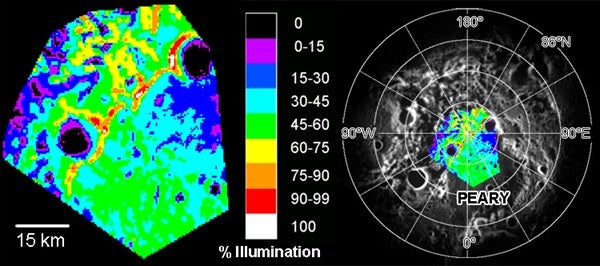Just as on Earth, areas around the Moon’s north pole apparently never have darkness during summer, according to research using decade-old images from the Clementine mission. The findings were announced at the March 2004 Lunar and Planetary Science Conference and have been published recently in Nature (April 14, 2005).
“Unlike the lunar south pole, which has no ‘mountains of eternal light,” says Bussey, “the north pole has peaks that are constantly illuminated, at least during lunar summer.” Bussey notes that the Clementine images were taken during the Moon’s north polar summer, so the continuous illumination may be a seasonal effect that disappears in winter, for which no data exist. The Moon’s axis, he points out, tilts about 1.5° relative to the plane of Earth’s orbit around the Sun, providing small but detectable seasons.
“A location near the north pole that was constantly lit would have a relatively benign environment,” Bussey says, noting the grazing angle of illumination. “Daily temperature changes would be only about 36° Fahrenheit [20° Celsius], making lunar base operations easier.” In contrast, at the lunar equator the angle of solar illumination can vary from grazing to straight down, producing temperature changes as great as 450° F (250° C) each day.
The team next plans to correlate the topographic results with hydrogen data from the Lunar Prospector mission, in hopes of locating permanently shadowed craters that might contain water or ice in the soil.
Meanwhile, the European Space Agency’s SMART-1 lunar probe is in orbit around the Moon and imaging its high latitudes. The spacecraft’s cameras should be able to settle the question of whether the Moon’s north polar peaks are always sunlit.










